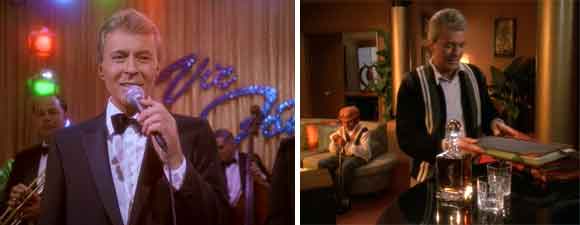Retro Review: Badda-Bing, Badda-Bang
6 min readWhen a programming glitch puts mobsters in charge of Vic’s holographic casino, crewmembers enact a scenario to save him.
Plot Summary: As gangsters and showgirls take over Vic’s holographic lounge, a shady character named Frankie Eyes warns Vic Fontaine that the hotel has been sold and Vic must clear out of town. O’Brien tries to delete the character, only to discover that the program’s designer, Felix, created a surprise twist in the program to make it more interesting. If the holosuite visitors can make Frankie leave within the confines of the program, its original parameters will be restored, but if Vic is killed or the program shut down, then Vic Fontaine will cease to exist. Because Vic was a good friend to Nog, Odo, Kira, and Bashir, the four convince the rest of the crew that they must help him, though Sisko is annoyed that they’re distracted from work and angrily points out to Kasidy Yates that African-Americans weren’t even allowed to visit casinos like Vic’s during the era when it’s supposed to exist. Yates points out that now the only restrictions on people of color are the ones they impose on themselves, persuading Sisko to enter the program and help the crew retake the casino from a mob boss named Zemo. Kira flirts with Frankie to keep him distracted while Dax, in her new job as a waitress, help Odo and Nog sneak into the back to steal Zeemo’s money, framing Frankie for the theft. Despite rehearsing the scam, many things go wrong, leading to Bashir having to threaten a money counter and Yates accidentally getting O’Brien strip-searched. Sisko manages to distract the crowd by giving money away while Nog breaks into the safe. Odo escapes with the money just before Frankie and Zeemo enter the counting room, only to find it all missing. After Zeemo’s thugs take Frankie away, the program resets to restore the original piano lounge. Vic provides champagne for the crew to toast in celebration and Sisko sings “The Best Is Yet To Come” with Vic.
Analysis: “Badda-Bing, Badda-Bang” is a skilfully-made episode, but I must admit I liked it better on first viewing. Having seen the terrific writing of the early season, and knowing how wonderful and sophisticated the concluding arc will be, it seems like pure fluff – well-done fluff, but nothing new or innovative, nothing the series couldn’t have done without. Surely it could have been tied into a larger story somehow, even something not of deep significance, like potential flaws in holosuite security? It’s very hard to believe that Sisko allowed his entire senior staff to spend so much time in a holographic fantasy he doesn’t much like in the first place, for completely understandable reasons, though the outrageous treatment of Native Americans in Western scenarios and women in the Dark Ages hasn’t seemed to bother any other users of the holodeck in much the same way that racial issues don’t get much lip service in Ocean’s Eleven, to which this is an obvious homage. No one even bothers to make the strongest case for crew intervention in the face of the potential death of a hologram, namely that Vic provides real morale-boosting for real soldiers in the Dominion War. There’s also a more esoteric case to be made – that a sentient hologram is a living being, like Voyager’s Emergency Medical Hologram, and deserves to be saved for his own sake, not for the assistance he’s given to crewmembers – but that opens a complicated discussion about the ethics of creating sentient holograms, particularly in programs that also contain “jack-in-the-box” programming twists like this one which leave those holograms open to torture and death, and for the most part, Star Trek’s writers have shirked that sort of discussion ever since The Next Generation‘s “Ship in a Bottle,” though I’d argue that the rights Picard procured for Data in “The Measure of a Man” should apply to sentient holograms as well.
“Badda-Bing, Badda-Bang” doesn’t attempt to address such questions, just to run with the scenario. It’s good fun in the way that “Specter of the Gun” was good fun on the original series and Q’s Robin Hood retelling was good fun on Next Gen – we’re not supposed to think about historical accuracy, and Sisko’s comments about race in the 1960s almost seem anachronistic given everything else we’ve been expected to repress about historical reenactments on Star Trek. It’s fine for Uhura to tell Abraham Lincoln that in a truly post-racial society, no potential epithet can upset her; but it’s apparently less true for Sisko, who’s had the recent experience of being Benny Russell, than it is for Yates, who’s comfortable playing a damsel in distress. At least this time when Kira and Dax put on skimpy clothing and flirt with bad men, they do so of their own choosing, unlike in Bashir’s James Bond-esque holo-serial. Am I allowed to complain that in an episode that specifically takes note of the racism of the 1960s, no one says one word about the station’s first officer, a Starfleet counselor, and a freighter captain being reduced to a gold-digging gangster’s girl, a down-on-her-luck waitress, and a simpering Southern belle? Is Sisko at all concerned about the stereotypes of mobsters from South Philly, Italian stock characters who populate the casino, or do people only look out for their own specific ancestry in his era? O’Brien seems no more fazed about having to play a harassed Irishman in the casino scenario than he does about the racial issues surrounding the Alamo roleplay in which he and Bashir are so invested. Despite Sisko’s speech, this episode wins no awards for sensitivity to identity politics.
What does work is its sense of humor, its enjoyment of play, the obvious deep connections between the characters, the well-developed relationships among both romantic couples – Sisko/Yates and Kira/Odo can both handle a bit of disagreement without it affecting their closeness – and the Starfleet friends who must work together on this decidedly un-Starfleet problem, though it’s a shame that Worf and Quark couldn’t be more involved – the latter in particular, since it’s his holosuite and therefore arguably HIS casino money at stake. It’s always a delight to see this crew out of uniform, and the costumes here are exceptional – Dax in her waitress tutu, Kira in a series of sexy gowns that she takes to with surprising ease (she’s had to use her feminine wiles before under less pleasant circumstances, with Cardassians and powerful Bajorans), Odo in his tux, Bashir in that adorable hat that makes him look shorter. I’m unconvinced that Sisko would know the words or melodic style of “The Best Is Yet To Come” given his previous aversion to this holo-scenario, but it’s apparent that Avery Brooks is a terrific stage performer, and now that we’ve seen him and Nana Visitor both sing with Vic, I am dying to see them perform a duet. I might have forgiven everything I consider to be fluff about this episode, or at least time-wasting, if I’d gotten that. I’m sure I’m overanalyzing the plot and themes when I should focus on the skilled directing – the sequence in which everyone walks slo-mo in costume into the casino is gorgeous – and the creative, glossy look of the thing, but the next time I’m skipping through DS9 episodes, “Badda-Bing, Badda-Bang” isn’t going to make the cut.







The reviewer goofs it here as this episode would not be an homage to Ocean’s Eleven considering that movie came out 2 years after “Bada Bing’s” airing.
http://www.imdb.com/title/tt0054135/?ref_=nv_sr_4
Wrong. Ocean’s Eleven is a heist film from 1960, with Frank Sinatra, Dean Martin, and Sammy Davis Jr. It was REMADE in the 90’s.
Ummmm; oops.
Just because you weren’t born yet when the original Ocean’s Eleven movie came out doesn’t mean that the history of cinema only started with your birth. In case you stumble upon the Beatles one day – they were around before NKTOB and Take That became the new boygroup sensations. (BTW: it seems you didn’t read anything related to the Clooney Ocean’s Eleven movie, otherwise you would have noticed the word “remake” and comparisons between both movies. Very sad example for ignorance …
“Despite Sisko’s speech, this episode wins no awards for sensitivity to identity politics.”
You know who sits down and wants to make sure his writing shows “sensitivity to identity politics”?
A shitty writer.
The Rat Pack. THE RAT PACK. My God, kids these days.
This is one of the worst Sisko episodes, because it forces him to step completely out of everything that had ever been established about his character and regress to the pettiness of a 20th century man, all so that he can spend half the episode brooding about how lousy casino busboys had it 400 years ago.
Almost everything the reviewer says is true, but this episode is great fun, no more, and no less; especially the ending. I loved “The Best is
Yet to Come.”
The 1960 original movie is what she’s talking about, not the remake (and I still want to get the soundtrack CD from the remake, most likely from Bittorrent or Amazon in physical form, assuming there’s any copies left.)
So one can produce no examples of good writing which is also racially sensitive? Does that make sense?
Apparently having white privilege pointed out takes them “out of the story” too much.
No, listening to 20th century racial bitching coming out of the mouth of a 24th century character takes us out of the story too much.
You know someone played Captain Kirk before Chris Pine too, right?
Being reminded of the existence of racism is never a bad thing; it’s called “Those who cannot learn from history are doomed to repeat it.” Sisko is clearly uncomfortable with the idea of being a black man playing around in a holographic version of a more racist time in human history. Combine that with his orb experience and I’m not surprised he’s a little more aware of 20th century race issues than the average 24th century person. It’d be far more “petty” if he elected not to participate at all, but he eventually does.
But yes how dreadful to be reminded of the way things were and *shock, horror* may in some ways still be! You have all the time in the world not to have to think about racism and other sorts of prejudices; be thankful for that privilege.